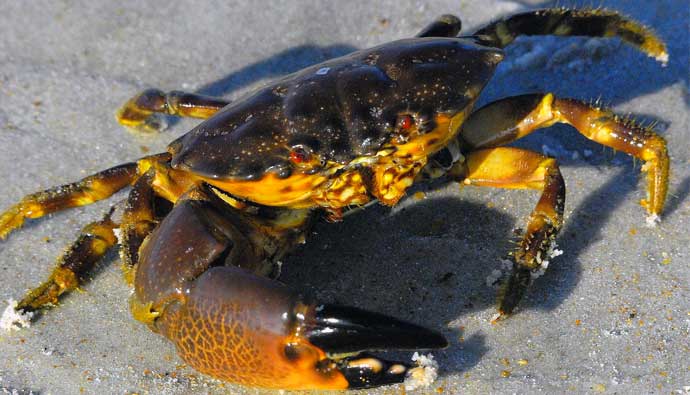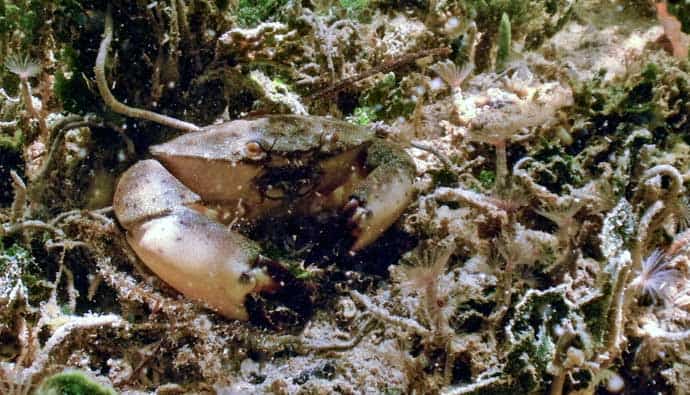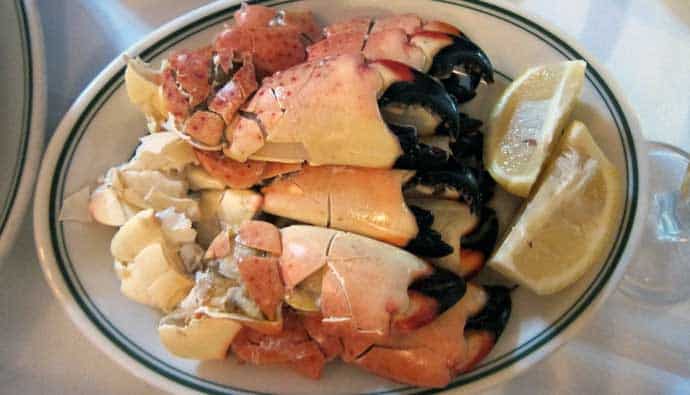Stone crabs are fun to catch and taste great! If you’re planning to catch some, here’s our complete guide on how to catch stone crabs.

In this article, we’re going to answer common questions like:
- Is the stone crab the best type of crab to eat?
- What does it feed on?
- How do you catch stone crabs?
Now let’s dive in!
Overview
The Florida stone crab can be found in the western North Atlantic and this includes the Gulf of Mexico, Cuba, the Bahamas and the east coast of the US. It can also be found in the salt marshes of Georgia and South Carolina.
The crab is mainly caught for food because of its excellent taste but you may confuse a genuine stone crab with a hybrid if you don’t know what to look for.

The carapace of the stone crab is about 6 inches wide and it is brownish-red in color with gray spots and a tan underside. Females are larger than the males but the males have larger chelae in comparison.
The crab sheds its limbs to escape predators or tight spaces but they always grow back. What is interesting is that each time it molts, it grows a new larger claw.
Stone crabs that molt are called soft shell crabs till their shell grows back.
Stone Crab Facts
| Scientific Name | Menippe mercenaria |
| Common Name(s) | Stone crab |
| Family | Menippidae |
| Identifying Characteristics | The carapace of the stone crab is about 6 inches wide and it is brownish-red in color with gray spots and a tan underside. Females are larger than the males but the males have larger chelae in comparison |
| Depth Range | 1 to 5 feet |
| Habitat | The stone crab can be found in the western North Atlantic and this includes the Gulf of Mexico, Cuba, the Bahamas and the east coast of the US. It can also be found in the salt marshes of Georgia and South Carolina. |
| Limits | Check your local regulations |
| Largest Recorded | The caught crab’s claw measured 148.9 mm |
Stone Crabs Habitat
Look for stone crabs near dock pilings, seawalls, and bridges in 6 inches to 3 feet deep water-filled holes. These usually have shells around the opening which the crab uses to dig deeper. They can also be found in knee-deep seagrass beds and reefs.
How to Catch Stone Crabs
You can catch stone crabs with a crab trap. Once you get one, fill the bait box with dead cut up fish (such as mullet, ladyfish etc) so that you can create some chum in the water.
Look for the stone crab in a grassy area that has some patches of sand around it and has water running through it.
Drop the trap in the area with the bait box open and make sure that the opening is in the same direction that the current is flowing. Leave the trap for at least 24 hours and then check if any crab were caught in it.
As per Florida law, you can only harvest stone crabs that have claws that are about 2 7/8 inches long-only and only claws may be harvested. Harvesting from egg-bearing crabs is prohibited.
Stone Crab Trapping Tactics
- Set 5 traps in a line at different locations and check them every 2 to 5 days for stone crabs.
- If you don’t want to use stone crab traps, lure the stone crab out of its hidey-hole by tempting it with a fish such as the whole ballyhoo.
Tips for Catching Stone Crabs
- If a stone crab has faint fingerprint-like markings on the propodus (the last segment of the pincer) you have a crab that has never been harvested before in your hands.
- Grab a stone crab over the top of the claws by the body and keep them pointed down and away
Stone Crab Season
Get your stone crabs schedule dialed in well in advance!
Stone Crab Season Florida
Stone crab season opens in Florida on October 15th and goes all the way till May 15th. That is the only time when you can harvest these stone crabs legally in the state. The spawning season lasts all spring and summer when the females lay millions of eggs.
How to Clean Stone Crabs
- Lay the crab on a cutting board with its belly side up and facing towards you.
- Place the tip of a sharp knife under the triangular piece of shell at the rear end of the crab and pry it open.
- Lift the upper shell of the crab completely off and discard the outer shell.
- Remove the flesh from the body and place it in a bowl.
- Remove the gills under the abdomen by grabbing and pulling them out with your hands.
- Hold the crab under running water to rinse out the viscera and guts.
- Twist off the legs from the body and crack them gently open with a hammer to remove the meat.
How to Cook Stone Crab Claws

Stone Crab Claw Recipe
- Put uncracked stone crab claws in a steamer basket and set over a pot of boiling water over high heat.
- Cover the stone crab claws and steam for about 5 minutes.
- Melt butter in a pan but not enough to turn it brown. Then pour it in a serving bowl.
- Remove the claws from the steamer, crack the shells and serve with the melted butter and some lemon wedges.
- If you’re adventurous, next time try fried crab claw…it’s also DELICIOUS!
Frequently Asked Questions
Females have a wide and long abdomen while male stone crabs have a narrower abdomen.
Once it loses a claw, the stone crab has to undergo several molt cycles to fully regenerate the lost appendage. This can take a year.
There is no precise method that can determine the age of a stone crab. Age is calculated according to molt frequency which suggests that males can live for 7 to 8 years while females can live up to 8 to 9 years.
Insider Advice
The stone crab may not be the biggest crab ever out there but its succulent meat more than makes up for its size. You can also wait for it to molt and try the soft shell variety if you want.
Do you have experience catching these crabs? Don’t be shy about sharing your experiences in the comments below and do share this guide if you liked it.
Remember, there’s always time for crab!





 Facebook
Facebook YouTube
YouTube








